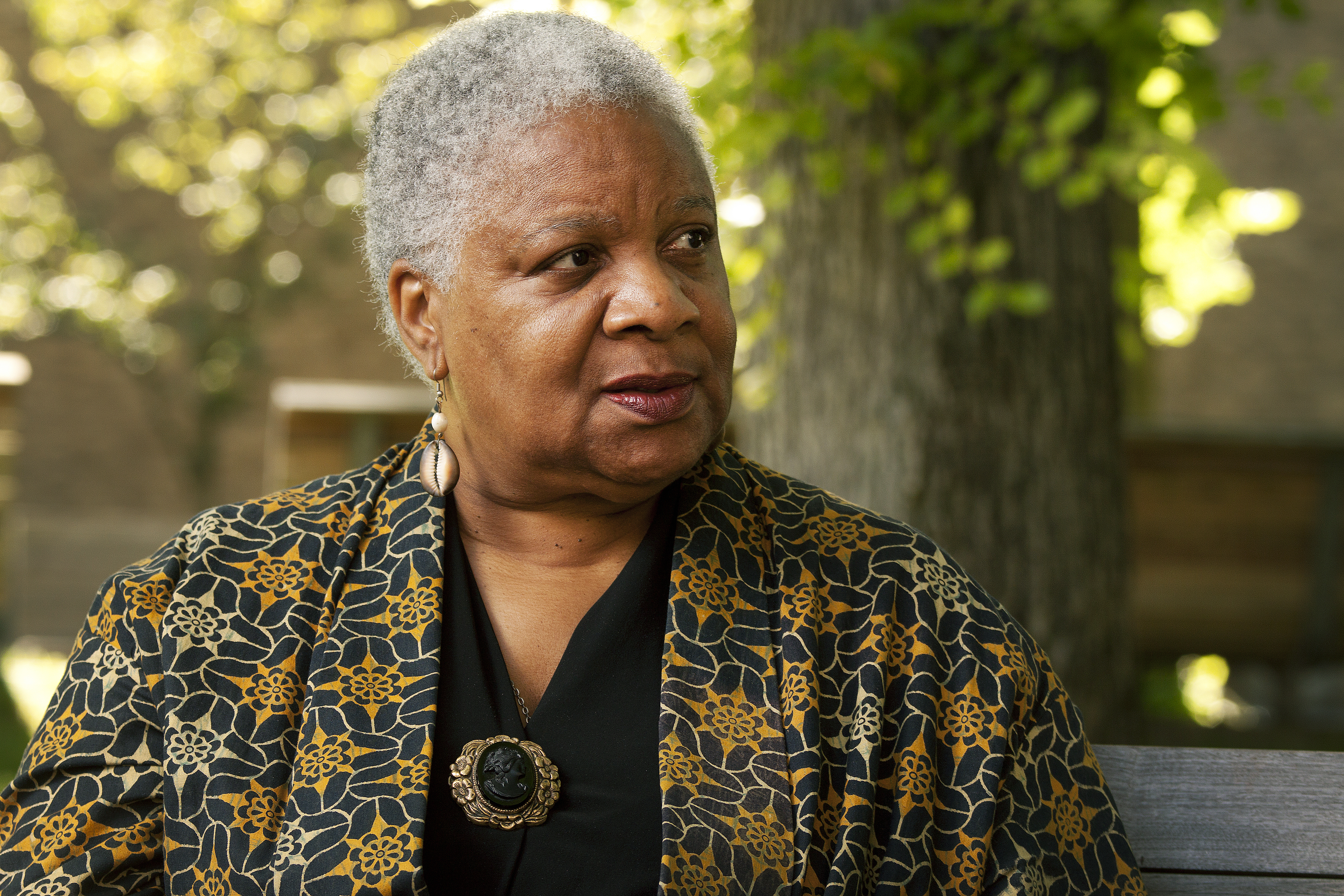Efforts to curb criminal justice disparities in Oregon have failed before. Will it be different this time?
Avel Gordly looks at the current legislative session and sees the past. The renewed focus on racial disparities in Oregon’s criminal justice system gives her hope, but also a sense of foreboding.
The former state lawmaker has seen it before: good intentions that go nowhere.
She’s heartened the current governor has a background in juvenile justice and a long history of combating discrimination. Gordly is convinced that Gov. Kate Brown understands the troubling data that emerged from our analysis of statewide court records — statistics showing that people of color in Oregon are far more likely than white residents to be charged with crimes.
But Gordly would like to see Oregon get serious about addressing those disparities. And she’s looking for more than a sympathetic ear in the governor’s office.
“Awareness is one thing,” Gordly said. “Taking action, and providing the quality of leadership that will be necessary, is something else.”
Brown’s staff did not respond to repeated requests for an interview with the governor.
Momentum
There was a time when Gordly and others thought Oregon had the leadership. And it came from an unlikely source.
Edwin Peterson is well-to do, white and Republican. Then chief justice of the Oregon Supreme Court, Peterson flew to Rockport, Maine, for the 40th annual Conference of Chief Justices in August 1988. There, Oregon’s top judge listened to stories from Michigan and New Jersey of rising racial disparities in police stops, charges and sentences. Something clicked.
“I thought to myself, ‘My God, if that is the situation in Michigan and New Jersey, that’s also the situation in Oregon.'”
The chief justice came back from Maine and pushed for a study to see whether Oregon’s criminal justice system was biased against people of color.
“Of course, we were hoping the report would be a catalyst for something, for some positive action,” Peterson recalled. “But I wasn’t born yesterday. I realized most reports of this kind are filed and continue to gather dust on the shelf.”
Preparing for his upcoming retirement from the bench, Peterson stepped down as chief justice in 1991, but continued to serve as a judge while he worked with Wallace P. Carson Jr. who succeeded him. Carson, in turn, embraced Peterson’s cause. He called for a task force on race in the criminal justice system and appointed Peterson to its head.
Starting in July 1992, the 18 members hosted nine town hall meetings, distributed more than 5,000 surveys, conducted hundreds of interviews, and combed through any statics they could find.
“I became painfully aware, during the study, that there was a paucity of data concerning the actions of law enforcement toward people of color,” Peterson said. “So we felt that problem should be addressed, and law enforcement agencies and courts should begin to keep records by race of arrests, stops, searches, probation decisions, pretrial release decisions and sentencing decisions — almost none of which existed during the time we did our study.”
In 1994, two years after they began, the task force published a 121-page report. People of color were more likely to be arrested, more likely to be charged, less likely to be released on bail, more likely to be convicted, less likely to be put on probation, and more likely to be sent to prison.
Attainable goals set
The report detailed 72 recommendations for change, focusing on access to interpreters, recruiting diverse lawyers and police, bias training, data collection and a statewide analysis of racial disparities in sentencing.
“We offer no pie-in-the-sky recommendations,” they wrote. “Every recommendation in this report is attainable within a reasonable time. Many recommendations are attainable at little or no cost.”
To Gordly, then a relatively new state representative, the report confirmed what she’d seen firsthand, growing up as an African-American in Northeast Portland and later, working as a parole and probation officer, where she says she was labeled a “troublemaker” for voicing concerns about disparate treatment of clients of color.
“Justice Peterson and Justice Carson emerged as not just advocates,” she said, “but champions for fairness in the administration of justice.”
Carson appointed Paul De Muniz, then an appellate court judge, to lead an Implementation Committee charged with pushing through the work of the Peterson Task Force. (De Muniz would go on to serve as the first Latino chief justice of the state Supreme Court.)
The group submitted a package of bills for consideration by the 1995 Legislature. Lawmakers approved two of the bills — one forbidding juror selection based on race, and the other forbidding racially prejudiced citizens from serving on a jury.
But all the others failed. One bill would have required prosecutors to document the perceived race of defendants, which would allow the state to analyze racial disparities in pretrial release, charging and sentencing. But the Oregon District Attorneys Association raised concerns about its $300,000 price tag. Prosecutors were stripped from the bill, leaving the racial-tracking legislation vague as it went into the budget committee, where it died.
Other bills sought to require interpreters to prove they were qualified and require state agencies to translate legal notices. None passed.
Following the largely unsuccessful 1995 session, the committee’s final report in 1996 was thick with strained optimism. It ended with a call for a third committee to keep the momentum alive.
The new Access to Justice for All Committee launched in 1997, but then shifted to other concerns including gender equality, the rights of disabled defendants, and foster care.
The committee was phased out in 2007, along with aspirations for a web portal detailing how those 72 recommendations from 1994 had been put into practice.
“I guess I was sort of naïve about the legitimate forces in the building,” De Muniz says today. “I came to understand how many things [lawmakers] were juggling. How many pushes and pulls exist. How many things are more important. We need health care for children. Well, is that a more pressing need than collecting some data? You know? So I get it.”
But it wasn’t just a lack of money that curbed the effort to look at racial disparities in the state’s criminal justice system.
A white state
Oregon was created partly as an escape from racial tensions and civil war in the United States in the early 1800s. Politicians banned people of color, then imposed lashes, forced labor, fines and taxes upon those who remained. Law enforcement was responsible for enforcing those rules. “We have a society that has been created by 400 years of favoritism to one racial group,” said Darrell Millner, a professor in Portland State University’s black studies department. “You’re not going to transform that in one year or one night or in one piece of legislation.”
The state’s demographics are changing. But Oregon’s elected leaders — like its prosecutors and police officers — are still overwhelmingly white. And that makes it easy to shrug off disparities as the result of socioeconomic constructs, not racial bias.
De Muniz recalls one proposal from the 1995 package that drew sharp opposition: standard training of judges and lawyers to discover their own implicit bias.
“Quite frankly it got a lot of pushback,” De Muniz said. “Because their own perception, like all of us, is that ‘I’m not biased when it comes to these things.’ There was some reluctance to say we might all be in need of some training. There was a perception that that wasn’t necessary.”
Over the past two decades, De Muniz said things have changed. Such training is still not mandatory, but he said many judges and lawyers have attended voluntarily.
But David Fidanque, the former director of the Oregon ACLU, says that a mind-set of denial persists today.
“I think we delude ourselves, people in power, delude ourselves into thinking there must be higher rates for crime in these groups. If nothing else, it must be based on something about class, not race or ethnicity,” said Fidanque, who spent more than three decades advocating for legislation to force lawmakers and law enforcement to examine why disparities persists.
Fidanque, who is white, says, “If it were happening to our children, we would be demanding change.”
Advocates for change battled the argument that Oregon already had made significant reforms to criminal justice. In 1975, lawmakers restored civil and political rights of felons, such as the right to vote, run for political office or obtain insurance. In 1989, the state adopted sentencing guidelines that created uniform sentences and set mandatory maximum prison terms. In 1991, Multnomah County was the second jurisdiction in the nation to implement a drug court diversion so addicts could receive treatment rather than prison time. Today, no one can go to prison simply for possessing small quantities of illegal drugs, and the state spends more per capita on public defense services than any other state except Alaska, Nevada and Massachusetts.
“Comparatively, you could look at Oregon’s system, you look at our sentence length compared to national lengths, especially Southern states, we’re a lot more reasonable,” said Michael Schmidt, director of the state’s Criminal Justice Commission. “There’s not as much low-hanging fruit. We’ve done a lot of the work.”
On the flip side, “tough on crime” laws adversely affected people of color. Oregon voters in 1994 passed Measure 11, mandating minimum sentences for the most serious crimes; including some crimes that people of color may commit at higher rates.
An analysis by the Criminal Justice Commission would later show that Latino defendants were 40 percent more likely than whites to be sentenced under the law, while black defendants would account for 10 percent of Measure 11 indictments and one-in-five indictments for second-degree robbery and murder.
In neighborhoods with more violent crime, you get more police, which leads to more scrutiny, which leads to more charging for all types of crime, said Charles French, a longtime prosecutor for Multnomah County, now retired.
“You take two kids, one from a white part of town and one from a minority part, and they commit the exact same crimes,” he said. “The black kid is going to have a rap sheet that’s longer, which leads to more severe sentencing. Incarceration leads to more crime. It’s a cycle.”
No buy-in
Gordly and other legislators got pushback from prosecutors who didn’t want to document the perceived race of defendants. They were burning through cases so fast, they might not ever meet a defendant during the course of plea negotiations with the defense attorney.
“How the hell do we find out race? Unless the officer designates it, there’s no way for us to know,” said Clatsop County District Attorney Josh Marquis, who was critical of Peterson’s 18-member committee with its one deputy prosecutor.
Police, in turn, didn’t want to be forced to collect the data either, and opposed a 2001 effort to mandate stop data collection — already a best practice recommended by national and international policing associations.
Even agencies that volunteered to collect the data didn’t believe it should be required. “You’re asking them to buy into something they don’t buy into,” said Ron Louie, retired Hillsboro Police chief. His was the first agency in the state to collect stop data.
“We chiefs, and cops in general, use numbers the same way a drunk uses a lamppost; more for support than illumination,” he said. “What does that tell you? If you took a look at the history of cops, you’ll find agencies flagrantly massaging and misusing their numbers.”
Agencies were concerned their officers would be labeled as racists by media that failed to consider the demographics of an officer’s beat. And they were worried about being sued for violating someone’s civil rights, said Gilbert Carrasco, a law professor at Willamette University and member of the oversight board set up to review data that came in voluntarily. Some agencies simply saw the entire exercise as “just more paperwork,” he said.
The wrong champion
Gordly says she initially was excited that the state’s most powerful judges had called for change in the criminal justice system. But from her perch in the Capitol, she saw that judges don’t hold sway with voters — or even progressive Democratic lawmakers, who look for support from the state’s police, sheriffs and district attorney associations.
The reason is simple, said former prosecutor French.
“If you get labeled as someone who is against law and order, you’ll lose,” he said. “So the Democrats, the last thing they want is to pass a law that blows up in their faces. They need one of the three organizations to agree. Then they have political cover.”
Police chiefs aren’t elected, and their power is comparatively weak. Sheriffs haven’t historically wielded much power either, French said. “That leaves DA associations.” But, he notes, there’s bad blood between Democratic lawmakers and the district attorneys stemming from a 2008 deal to head off stricter sentences for property and drug crimes. Prosecutors backed a more moderate measure, which won out. But then the Legislature froze its implementation citing budget constraints.
“They turned around and stabbed the DAs in the back. It was the worst thing the Legislature could have done,” French said. “It has so poisoned the atmosphere that everything was looked at with complete suspicion.”
New Moves
As lawmakers enter the 2017 session, momentum for criminal justice reform has grown in Salem, sparked by a resurgent civil rights movement, media coverage of police shootings, and a divisive presidential election.
Advocates of criminal justice reform hope to avoid a repeat of the 2015 session, when state Reps. Lew Frederick, D-Salem, and Alissa Keny-Guyer, D-Portland, pushed through a proposal to require police and prosecutors to maintain more comprehensive policies on racial profiling and develop a process of complaint.
The original bill included disciplinary action for officers found to have targeted people of color and mandatory cultural competency training. The final language narrowed the definition of profiling and jettisoned reference to training and discipline. Instead the bill allowed for a new task force headed by Attorney General Ellen Rosenblum to propose further change.
“I wasn’t disappointed,” Frederick said. “I looked at it as a first step, and Ellen’s bill is the next step.”
Frederick is referring to House Bill 2355, being pushed by Rosenblum this session. It incorporates the task force’s key recommendations for mandatory traffic-stop data collection, profiling education for police, and dropping simple drug possession to a misdemeanor. (Gov. Brown also has a bill to reform drug sentences.)
Senate President Peter Courtney, a Democrat from Salem, said he’s heartened that police and sheriff’s associations have thrown their support behind the sentencing reforms. And, he said the publication of statewide court statistics showing racial disparities at other levels of the criminal justice system could build support for mandatory stop data.
It’s not clear, however, that anyone will take on the role of champion.
Rosenblum herself is facing a federal lawsuit alleging profiling after a staff member tracked one of her own civil rights attorney’s social media posts regarding Black Lives Matter, a civil rights group protesting police abuse.
While there was no evidence she authorized the surveillance, Rosenblum immediately apologized. She said policies changed, employees were trained and personnel changed. “I continue to forcefully oppose conduct that even smells like profiling in my shop,” she said.
But Gordly and others have said the controversy strips Rosenblum of the moral authority needed to push for meaningful change.
Rosenblum said she has been an unwavering champion of equity. The years of research, reports, task forces and hearings — they were necessary to build momentum, she said. This time things will be different. This session things will change.
“I feel like we’re at a real point where we can actually get something on the books,” she said.
Appellate Court Judge Darleen Ortega was a member of the third and final “Access” committee intended to address some of the racial disparities in the system. She was not surprised at its failure, or that of the committee before it, or the task force before that. Ortega, the first Latina appointed to an appellate court in Oregon, also is a candidate for a seat on the state’s Supreme Court.
She said most people in Oregon simply don’t take racism seriously, and she doesn’t think that much has changed.
“I have sat on tons of committee on this topic, and we haven’t talked about racism in a very realistic way,” she said. “If we talk about racism at all, it’s an idea of racism that’s very crude. Racism is people wearing hoods and painting swastikas.”
What’s less obvious, she said, is how policies continue to impact people of color in a state where few of them hold positions of power. The 2017 Legislature has more members who are people of color (nine) than any time in history. And still, 90 percent are white.
“We don’t recognize racism when it’s baked into our system,” Ortega said. “It’s enacted by well- meaning people who can’t see they’re enacting it.”
Lee van der Voo contributed reporting to this article.





